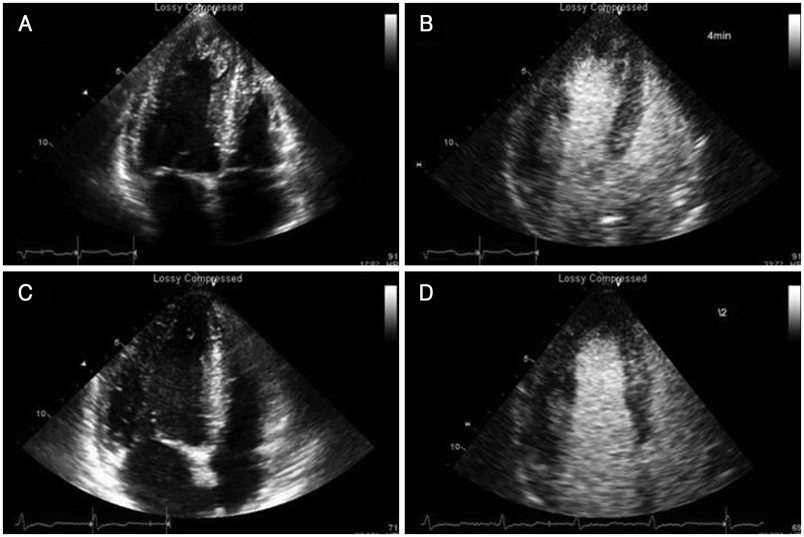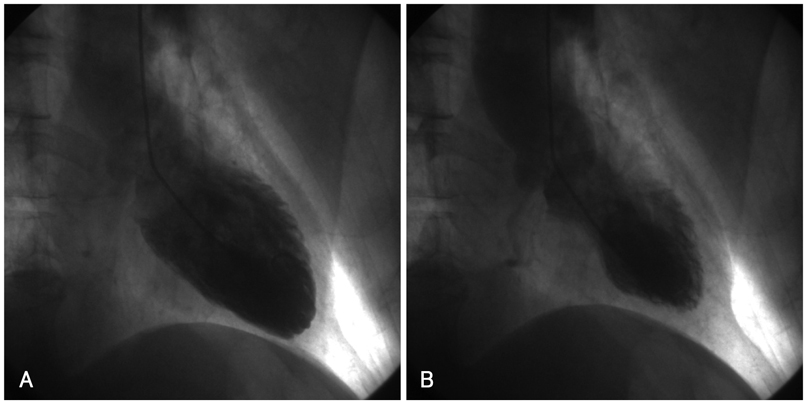Clinical Characteristics and Prognostic Factors of Stress-Induced Cardiomyopathy
- Affiliations
-
- 1Division of Cardiology, Department of Internal Medicine, Wonju College of Medicine, Yonsei University, Wonju, Korea. kimjy@yonsei.ac.kr
- KMID: 2225188
- DOI: http://doi.org/10.4070/kcj.2010.40.6.277
Abstract
- BACKGROUND AND OBJECTIVES
Stress-induced cardiomyopathy (SCM) is characterized by a transient left ventricular (LV) dysfunction due to emotional and physical stress. There are limited data about the clinical characteristics in Korean patients. We sought to clarify the clinical features and prognosis in patients with SCM.
SUBJECTS AND METHODS
We reviewed 39 cases diagnosed with SCM in a tertiary hospital. The SCM was diagnosed as: 1) no previous history of cardiac disease, 2) acute onset, 3) regional wall motion abnormality, typically in the takotsubo or inverted takotsubo shape by echocardiography, and 4) no significant stenosis in the coronary angiogram. We evaluated clinical characteristics, biomarkers, and prognosis.
RESULTS
Mean age was 61.3+/-16.1 years (female 69%). The triggering factors were physical stress in 32 patients (82%) and emotional stress in 5 patients (13%). The initial symptom was dyspnea (n=18, 46%) rather than chest pain (n=10, 26%). An initial electrocardiogram (EKG) presented T-wave inversion (n=18, 46%), ST-elevation (n=11, 28%), and ST-depression (n=2, 5%). Multivariate logistic regression analysis showed that initial high sensitive C-reactive protein (hs-CRP) {odds ratio (OR) 1.41, 95% confidence interval (CI); 1.02-1.97} and initial left ventricular ejection fraction (LVEF) (OR 0.89, 95% CI; 0.80-0.98) were significantly associated with death or cardiogenic shock, respectively.
CONCLUSION
The major triggering factor of SCM is physical stress due to illness or surgical procedures, and the first manifestation is dyspnea rather than chest pain. Elevated hs-CRP and decreased LVEF at admission were independent risk factors for death or cardiogenic shock.
MeSH Terms
Figure
Cited by 5 articles
-
KSHF Guidelines for the Management of Acute Heart Failure: Part III. Specific Management of Acute Heart Failure According to the Etiology and Co-morbidity
Min-Seok Kim, Ju-Hee Lee, Hyun-Jai Cho, Jae Yeong Cho, Jin-Oh Choi, Kyung Kuk Hwang, Byung Su Yoo, Seok-Min Kang, Dong-Ju Choi
Korean Circ J. 2019;49(1):46-68. doi: 10.4070/kcj.2018.0351.Stress-Induced Cardiomyopathy: The Role of Echocardiography
Jun-Won Lee, Jang-Young Kim
J Cardiovasc Ultrasound. 2011;19(1):7-12. doi: 10.4250/jcu.2011.19.1.7.Different Characteristics between Patients with Apical and Non-Apical Subtypes of Stress-Induced Cardiomyopathy
Sun Hwa Lee, Won Ho Kim, Sang Rok Lee, Kyung Suk Rhee, Jei Keon Chae, Jae Ki Ko
J Cardiovasc Ultrasound. 2013;21(3):116-122. doi: 10.4250/jcu.2013.21.3.116.Variable Morphology of Stress-Induced Cardiomyopathy
Dong Ryeol Ryu
J Cardiovasc Ultrasound. 2013;21(3):113-115. doi: 10.4250/jcu.2013.21.3.113.Ventricular Septal Rupture in a Case Suspected as Stress Induced Cardiomyopathy
Hyo-In Rhyou, Tae-Ho Park, Ji-Eun Han, Moo-Hyun Kim, Young-Dae Kim
J Cardiovasc Ultrasound. 2015;23(3):173-176. doi: 10.4250/jcu.2015.23.3.173.
Reference
-
1. Bybee KA, Kara T, Prasad A, et al. Systematic review: transient left ventricular apical ballooning: a syndrome that mimics ST-segment elevation myocardial infarction. Ann Intern Med. 2004. 141:858–865.2. Grawe H, Katoh M, Kuhl HP. Stress cardiomyopathy mimicking acute coronary syndrome: case presentation and review of the literature. Clin Res Cardiol. 2006. 95:179–185.3. Dote K, Sato H, Tateishi H, Uchida T, Ishihara M. Myocardial stunning due to simultaneous multivessel coronary spasms: a review of 5 cases. J Cardiol. 1991. 21:203–214.4. Abe Y, Kondo M, Matsuoka R, Araki M, Dohyama K, Tanio H. Assessment of clinical features in transient left ventricular apical ballooning. J Am Coll Cardiol. 2003. 41:737–742.5. Lee HH, Gwon HC, Kim BJ, et al. Clinical manifestation of novel stress-induced cardiomyopathy mimicking acute myocardial infarction: single center prospective registry. Korean Circ J. 2002. 32:1054–1063.6. Chang KY, Jeon HK, Chae JS, et al. A novel cardiomyopathy mimicking acute myocardial infarction. Korean Circ J. 2002. 32:608–612.7. Morel O, Sauer F, Imperiale A, et al. Importance of inflammation and neurohumoral activation in Takotsubo cardiomyopathy. J Card Fail. 2009. 15:206–213.8. Zelinka T, Petrak O, Strauch B, et al. Elevated inflammatory markers in pheochromocytoma compared to other forms of hypertension. Neuroimmunomodulation. 2007. 14:57–64.9. Kurisu S, Sato H, Kawagoe T, et al. Tako-tsubo-like left ventricular dysfunction with ST segment elevation: a novel cardiac syndrome mimicking acute myocardial infarction. Am Heart J. 2002. 143:448–455.10. Tsuchihashi K, Ueshima K, Uchida T, et al. Transient left ventricular apical ballooning without coronary artery stenosis: a novel heart syndrome mimicking acute myocardial infarction. J Am Coll Cardiol. 2001. 38:11–18.11. Desmet WJ, Adriaenssens BF, Dens JA. Apical ballooning of the left ventricle: first series in white patients. Heart. 2003. 89:1027–1031.12. Bybee KA, Prasad A, Barsness GW, et al. Clinical characteristics and thrombolysis in myocardial infarction frame counts in women with transient left ventricular apical ballooning syndrome. Am J Cardiol. 2004. 94:343–346.13. Sharkey SW, Lesser JR, Zenovich AG, et al. Acute and reversible cardiomyopathy provoked by stress in women from the United States. Circulation. 2005. 111:472–479.14. Wittstein IS, Thiemann DR, Lima JA, et al. Neurohumoral features of myocardial stunning due to sudden emotional stress. N Engl J Med. 2005. 352:539–548.15. Regnante RA, Zuzek RW, Weinsier SB, et al. Clinical characteristics and four-year outcomes of patients in the Rhode Island Takotsubo Cardiomyopathy Registry. Am J Cardiol. 2009. 103:1015–1019.16. Lambert G, Naredi S, Eden E, Rydenhag B, Friberg P. Monoamine metabolism and sympathetic nervous activation following subarachnoid haemorrhage: influence of gender and hydrocephalus. Brain Res Bull. 2002. 58:77–82.17. Ueyama T, Hano T, Kasamatsu K, Yamamoto K, Tsuruo Y, Nishio I. Estrogen attenuates the emotional stress-induced cardiac responses in the animal model of Tako-tsubo (Ampulla) cardiomyopathy. J Cardiovasc Pharmacol. 2003. 42:Suppl 1. S117–S119.18. Ueyama T, Kasamatsu K, Hano T, Tsuruo Y, Ishikura F. Catecholamines and estrogen are involved in the pathogenesis of emotional stress-induced acute heart attack. Ann N Y Acad Sci. 2008. 1148:479–485.19. Park JH, Kang SJ, Song JK, et al. Left ventricular apical ballooning due to severe physical stress in patients admitted to the medical ICU. Chest. 2005. 128:296–302.20. Hahn JY, Gwon HC, Park SW, et al. The clinical features of transient left ventricular nonapical ballooning syndrome: comparison with apical ballooning syndrome. Am Heart J. 2007. 154:1166–1173.21. Hurst RT, Askew JW, Reuss CS, et al. Transient midventricular ballooning syndrome: a new variant. J Am Coll Cardiol. 2006. 48:579–583.
- Full Text Links
- Actions
-
Cited
- CITED
-
- Close
- Share
- Similar articles
-
- A case of stress-induced cardiomyopathy with an "inverted Takotsubo" contractile pattern
- Recurrent fetal postpartum stress induced cardiomyopathy after normal vaginal delivery
- Stress-induced cardiomyopathy during ophthalmologic surgery: A case report
- Left Ventricular Thrombus Associated with Takotsubo Cardiomyopathy: A Cardioembolic Cause of Cerebral Infarction
- Stress-induced Cardiomyopathy Associated with Non-Small Cell Lung Cancer Presenting as Hyponatremia



